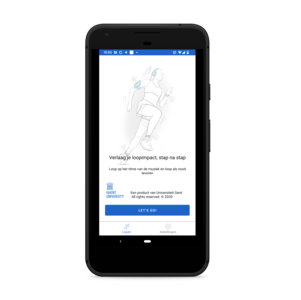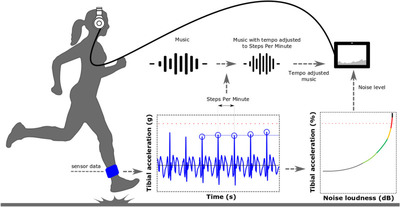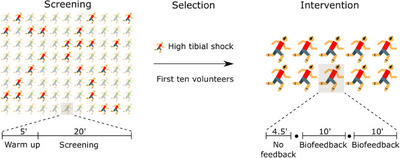~ Low impact runner: a music based bio-feedback system
» By Joren on Saturday 01 October 2022Fig: schema of the low impact runner system.
I have been lucky to have been involved in an interdisciplinary research project around the low impact runner: a music based bio-feedback system to reduce tibial shock in over-ground running. In the beginning of October 2022 the PhD defence of Rud Derie takes place so it is a good moment to look back to this collaboration between several branches of Ghent University: IPEM , movement and sports science and IDLab.
The idea behind the project was to first select runners with a high foot-fall impact. Then an intervention would slightly nudge these runner to a running style with lower impact. A lower repetitive impact is expected to reduce the chance on injuries common for runners. A system was invented in which musical bio-feedback was given on the measured impact. The schema to the right shows the concept.
I was involved in development of the first hardware prototypes which measured acceleration on the legs of the runner and the development of software to receive and handle these measurement on a tablet strapped to a backpack the runner was wearing. This software also logged measurements, had real-time visualisation capabilities and allowed remote control and monitoring over the network. Finally measurements were send to a Max/MSP sonification engine. These prototypes of software and hardware were replaced during a valorization project but some parts of the software ended up in the final Android application.
Video: the left screen shows the indoor positioning system via UWB (ultra-wide-band) and the right screen shows the music feedback system and the real time monitoring of impact of the runner. Video by Pieter Van den Berghe
Over time the first wired sensors were replaced with wireless Bluetooth versions. This made the sensors easy to use and also to visualize sensor values in the browser thanks to the Web Bluetooth API. I have experimented with this and made two demos: a low impact runner visualizer and one with the conceptual schema.
Vid: Visualizing the Bluetooth Low Impact Runner sensor in the browser.
The following three studies shows a part of the trajectory of the project. The first paper is a validation of the measurement system. Secondly a proof-of-concept study is done which finally greenlights a larger scale intervention study.
-
Van den Berghe, P., Six, J., Gerlo, J., Leman, M., & De Clercq, D. (2019). Validity and reliability of peak tibial accelerations as real-time measure of impact loading during over-ground rearfoot running at different speeds. Journal of Biomechanics, 86, 238-242.
-
Van den Berghe, P., Lorenzoni, V., Derie, R., Six, J., Gerlo, J., Leman, M., & De Clercq, D. (2021). Music-based biofeedback to reduce tibial shock in over-ground running: A proof-of-concept study. Scientific reports, 11(1), 1-12.
-
Van den Berghe, P., Derie, R., Bauwens, P., Gerlo, J., Segers, V., Leman, M., & De Clercq, D. (2022). Reducing the peak tibial acceleration of running by music‐based biofeedback: A quasi‐randomized controlled trial. Scandinavian Journal of Medicine & Science in Sports
There are quite a number of other papers but I was less involved in those. The project also resulted in two PhD’s:
- Motor retraining by real-time sonic feedback: understanding strategies of low impact running (2021) by Pieter Van den Berghe
- Running on good vibes: music induced running-style adaptations for lower impact running (2022) by Rud Derie
I am also recognized as co-inventor on the low impact runner system patent and there are concrete plans for a commercial spin-off. To be continued…




